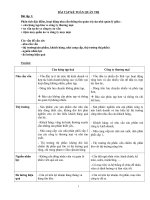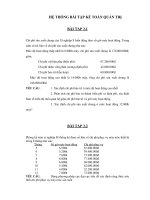ch12ex bai tap ke toan quan tri
Bạn đang xem bản rút gọn của tài liệu. Xem và tải ngay bản đầy đủ của tài liệu tại đây (319.03 KB, 3 trang )
Exercises: Set B
o l l e g e/ w
/c
www
.
Exercises: Set B
1
g a n dt
wi
ey
ley.co m
E12-1B Allen Corporation is considering purchasing a new delivery truck. The truck
has many advantages over the company’s current truck (not the least of which is that it
runs). The new truck would cost $48,000. Because of the increased capacity, reduced
maintenance costs, and increased fuel economy, the new truck is expected to generate
cost savings of $8,000. At the end of 8 years the company will sell the truck for an estimated $20,000. Traditionally the company has used a rule of thumb that a proposal should
not be accepted unless it has a payback period that is less than 70% of the asset’s estimated useful life. Achin Ceban, a new manager, has suggested that the company should
not rely solely on the payback approach, but should also employ the net present value
method when evaluating new projects. The company’s cost of capital is 9%.
Compute cash payback and
net present value.
(SO 2, 3)
Instructions
(a) Compute the cash payback period and net present value of the proposed investment.
(b) Does the project meet the company’s cash payback criteria? Does it meet the net
present value criteria for acceptance? Discuss your results.
E12-2B Kogama Manufacturing Company is considering three new projects, each
requiring an equipment investment of $25,000. Each project will last for 3 years and produce the following cash inflows.
Year
AA
BB
CC
1
2
3
$ 7,000
9,000
12,000
$ 9,600
9,600
9,600
$13,000
9,000
11,000
Total
$28,000
$28,800
$33,000
Compute cash payback period
and net present value.
(SO 2, 3)
The equipment’s salvage value is zero. Kogama uses straight-line depreciation. Kogama
will not accept any project with a payback period over 2.5 years. Kogama’s minimum
required rate of return is 12%.
Instructions
(a) Compute each project’s payback period, indicating the most desirable project and the
least desirable project using this method. (Round to two decimals.)
(b) Compute the net present value of each project. Does your evaluation change? (Round
to nearest dollar.)
E12-3B SWC Corp. is considering purchasing one of two new diagnostic machines.
Either machine would make it possible for the company to bid on jobs that it currently
isn’t equipped to do. Estimates regarding each machine are provided below.
Original cost
Estimated life
Salvage value
Estimated annual cash inflows
Estimated annual cash outflows
Machine A
Machine B
$98,000
8 years
–0–
$25,000
$5,000
$170,000
8 years
–0–
$40,000
$12,000
Compute net present value
and profitability index.
(SO 3, 5)
Instructions
Calculate the net present value and profitability index of each machine. Assume a 10%
discount rate. Which machine should be purchased?
E12-4B Valdez Inc. manufactures snowsuits. Valdez is considering purchasing a new
sewing machine at a cost of $2.4 million. Its existing machine was purchased five years
ago at a price of $1.8 million; six months ago, Valdez spent $55,000 to keep it operational. The existing sewing machine can be sold today for $260,000. The new sewing
machine would require a one-time, $85,000 training cost. Operating costs would decrease
by the following amounts for years 1 to 7:
Calculate net present value
and apply decision rule.
(SO 3)
2
chapter 12 Planning for Capital Investments
Year 1
2
3
4
5
6
7
$390,000
400,000
411,000
426,000
434,000
435,000
436,000
The new sewing machine would be depreciated according to the declining-balance
method at a rate of 20%. The salvage value is expected to be $380,000. This new equipment would require maintenance costs of $95,000 at the end of the fifth year. The cost
of capital is 10%.
Instructions
Use the net present value method to determine whether Valdez should purchase the new
machine to replace the existing machine, and state the reason for your conclusion.
(CGA adapted)
Calculate payback period,
internal rate of return, and
apply decision rules.
(SO 2, 7)
E12-5B BTMS Inc. wants to purchase a new machine for $30,000, excluding $1,500 of
installation costs. The old machine was bought five years ago and had an expected economic life of 10 years without salvage value. This old machine now has a book value of
$2,000, and BTMS Inc. expects to sell it for that amount. The new machine would decrease
operating costs by $8,000 each year of its economic life. The straight-line amortization
method would be used for the new machine, for a five-year period with no salvage value.
Instructions
(a) Determine the cash payback period.
(b) Determine the approximate internal rate of return.
(c) Assuming the company has a required rate of return of 10%, state your conclusion
on whether the new machine should be purchased.
(CGA adapted)
Determine internal rate of
return.
(SO 7)
E12-6B Hines Corporation is involved in the business of injection molding of plastics.
It is considering the purchase of a new computer-aided design and manufacturing machine for $436,000. The company believes that with this new machine it will improve productivity and increase quality, resulting in an increase in net annual cash flows of $115,000
for the next 5 years. Management requires a 12% rate of return on all new investments.
Instructions
Calculate the internal rate of return on this new machine. Should the investment be
accepted?
Determine internal rate of
return.
(SO 7)
E12-7B Omega Company is considering three capital expenditure projects. Relevant
data for the projects are as follows.
Annual
Life of
Project
Investment
Income
Project
22A
23A
24A
$231,000
270,000
288,000
$11,400
17,000
20,000
6 years
8 years
9 years
Annual income is constant over the life of the project. Each project is expected to have
zero salvage value at the end of the project. Omega Company uses the straight-line
method of depreciation.
Instructions
(a) Determine the internal rate of return for each project. Round the internal rate of
return factor to three decimals.
(b) If Omega Company’s minimum required rate of return is 9%, which projects are
acceptable?
Calculate annual rate
of return.
(SO 8)
E12-8B Funtado Company is considering opening a new hair salon in Tucson, Arizona.
The cost of building a new salon is $400,000. A new salon will normally generate annual
revenues of $87,500, with annual expenses (including depreciation) of $40,000. At the
end of 20 years the salon will have a salvage value of $100,000.
Exercises: Set B
3
Instructions
Calculate the annual rate of return on the project.
E12-9B Thorstad Service Center just purchased an automobile hoist for $18,600. The
hoist has a 5-year life and an estimated salvage value of $1,400. Installation costs were
$3,900, and freight charges were $900. Thorstad uses straight-line depreciation.
The new hoist will be used to replace mufflers and tires on automobiles. Thorstad
estimates that the new hoist will enable his mechanics to replace five extra mufflers per
week. Each muffler sells for $75 installed. The cost of a muffler is $35, and the labor cost
to install a muffler is $15.
Compute cash payback
period and annual rate of
return.
(SO 2, 8)
Instructions
(a) Compute the payback period for the new hoist.
(b) Compute the annual rate of return for the new hoist. (Round to one decimal.)
E12-10B Solano Company is considering a capital investment of $210,000 in additional productive facilities. The new machinery is expected to have a useful life of
5 years with no salvage value. Depreciation is by the straight-line method. During the
life of the investment, annual net income and cash inflows are expected to be $20,000
and $60,000, respectively. Solano has a 12% cost of capital rate, which is the minimum
acceptable rate of return on the investment.
Computer annual rate of
return, cash payback period,
and net present value.
(SO 2, 3, 8)
Instructions
(Round to two decimals.)
(a) Compute (1) the cash payback period and (2) the annual rate of return on the
proposed capital expenditure.
(b) Using the discounted cash flow technique, compute the net present value.
E12-11B MCA Corporation is reviewing an investment proposal. The initial cost and
estimates of the book value of the investment at the end of each year, the net cash flows
for each year, and the net income for each year are presented in the schedule below. All
cash flows are assumed to take place at the end of the year. The salvage value of the investment at the end of each year is equal to its book value. There would be no salvage
value at the end of the investment’s life.
Investment Proposal
Year
Initial Cost
and Book Value
Annual
Cash Flows
Annual
Net Income
0
1
2
3
4
5
$105,000
70,000
42,000
21,000
7,000
0
$45,000
40,000
35,000
30,000
25,000
$16,000
18,000
20,000
22,000
24,000
MCA Corporation uses a 15% target rate of return for new investment proposals.
Instructions
(a) What is the cash payback period for this proposal?
(b) What is the annual rate of return for the investment?
(c) What is the net present value of the investment?
(CMA-Canada adapted)
Calculate payback, annual
rate of return, and net
present value.
(SO 2, 3, 8)









